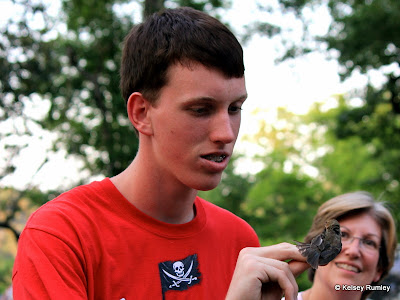“Hope is the thing with feathers” ~Emily Dickinson
The Green Leadership Academy for Diverse Ecosystems (GLADE) activity of mist netting and bird banding illustrates beautifully the moment when students truly engage in and connect with nature. In the cognitive domain, it enables students to fully participate in important scientific research. In the affective domain, it allows the students to observe the traits of the neotropical migrant, and incorporate them into one’s own fabric. Both actions serve to unearth a sense of potential within that is vital to becoming an effective leader.
The bird banding activity is part of a larger scientific research project of the Institute for Bird Populations. The specific outreach project of the institute is called the Monitoring Avian Productivity and Survivorship (MAPS) Program. According to its website at www.birdpop.org/maps.htm, MAPS “comprises a continent-wide network of hundreds of constant-effort mist netting stations. Analyses of the resulting banding data provide critical information relating to the ecology, conservation, and management of North American landbird populations, and the factors responsible for changes in their populations.” GLADE staff members Dr. Janice Greene and Andrew Kinslow participate annually in the census project.
The MAPS project provides an opportunity to impact humans as well as birds. The convergence of life paths between these nearly weightless, beautiful, long-distance sojourners and the GLADE naturalists brings knowledge of and appreciation for the survival strategies of the neotropical migrants. The migratory routes of these birds also connect two worlds for the youth. Our own Ozarks habitats and Central and South American habitats, where nesting migratory species of the Ozarks spend much of their lives, are suddenly linked in the minds of the young people. The bird banding activity literally and figuratively expands horizons, and increases global ecological awareness. It provides a key to unlocking an overwhelming appreciation for all life and an opportunity to think about the possibilities of conservation partnerships across the entire geographic range of these fascinating avian travelers.
During the morning activity, resident and neotropical species are netted, bagged and taken to an open-air banding table, where students engage in ornithological pursuits---measuring, aging, sexing, weighing, and banding cause the time to stand still. Students embrace the experience with the resident and neotropical species. In doing so, they develop a new perspective on birds. A sense of calm becomes palpable within the group of young naturalists. Countenances reveal an inner change taking place.
They say that a picture says a thousand words. If so, the photographs of Kelsey Rumley, GLADE 2010, spin a heartwarming tale.
Taylor gazes at an Indigo Bunting while Martha observes.
Introspective onlookers watch Heather, as Baillie delights in an Indigo Bunting.
A brightly colored male Summer Tanager puts a glow on Jessi’s face.
Jessi appreciates the contrasting Black-and-white Warbler.
Bryanna studies the Brown Thrasher in depth.
Tim enjoys the beauty of the Summer Tanager.







No comments:
Post a Comment